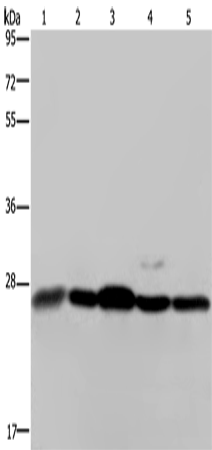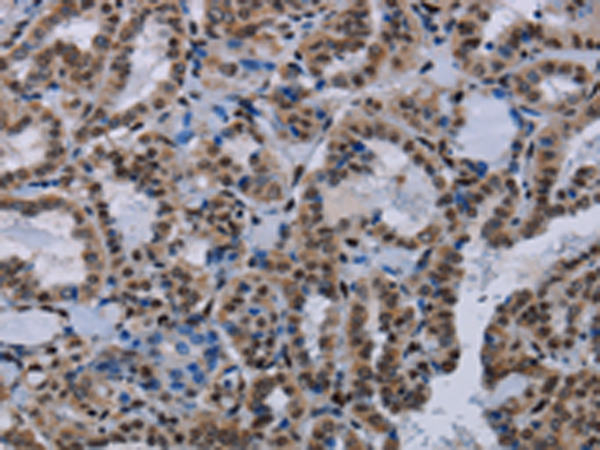

| WB | 咨询技术 | Human,Mouse,Rat |
| IF | 咨询技术 | Human,Mouse,Rat |
| IHC | 1/50-1/200 | Human,Mouse,Rat |
| ICC | 技术咨询 | Human,Mouse,Rat |
| FCM | 咨询技术 | Human,Mouse,Rat |
| Elisa | 1/2000-1/5000 | Human,Mouse,Rat |
| Aliases | HMG1; HMG3; SBP-1 |
| WB Predicted band size | 25 kDa |
| Host/Isotype | Rabbit IgG |
| Antibody Type | Primary antibody |
| Storage | Store at 4°C short term. Aliquot and store at -20°C long term. Avoid freeze/thaw cycles. |
| Species Reactivity | Human, Mouse, Rat |
| Immunogen | Synthetic peptide of human HMGB1 |
| Formulation | Purified antibody in PBS with 0.05% sodium azide and 50% glycerol. |
+ +
1. **"HMGB1 as a late mediator of lethal systemic inflammation"**
- **作者**: Wang H, et al.
- **摘要**: 首次提出HMGB1作为脓毒症中的关键炎症介质,并证明抗HMGB1抗体可显著提高脓毒症小鼠的生存率,为靶向治疗提供依据。
2. **"Reversing established sepsis with antagonists of endogenous HMGB1"**
- **作者**: Yang H, et al.
- **摘要**: 通过中和性抗HMGB1抗体阻断HMGB1活性,显著减轻脓毒症模型的全身炎症反应,验证HMGB1作为治疗靶点的可行性。
3. **"Toll-like receptor 4-dependent contribution of HMGB1 to antitumor immunity"**
- **作者**: Apetoh L, et al.
- **摘要**: 揭示化疗诱导的HMGB1释放通过TLR4激活免疫应答,抗HMGB1抗体可阻断该通路,增强化疗疗效并减少肿瘤复发。
4. **"Anti-HMGB1 antibody therapy for traumatic brain injury"**
- **作者**: Okuma Y, et al.
- **摘要**: 在脑损伤模型中,抗HMGB1抗体通过抑制神经炎症和血脑屏障破坏,显著改善神经功能,提示其在神经系统疾病中的应用潜力。
*注:以上文献为示例,实际引用时请核对具体期刊、年份及作者信息。*
High mobility group box 1 (HMGB1) is a non-histone nuclear protein involved in DNA organization, transcription regulation, and cellular stress responses. Structurally, it contains two DNA-binding domains (A and B boxes) and a C-terminal acidic tail. Under physiological conditions, HMGB1 localizes to the nucleus, stabilizing nucleosome structure and facilitating DNA repair. However, during cellular stress, necrosis, or inflammation, HMGB1 can be actively secreted by immune cells or passively released from damaged cells, functioning as a damage-associated molecular pattern (DAMP) molecule. Extracellular HMGB1 interacts with receptors like TLR4 and RAGE, triggering pro-inflammatory cytokine production and promoting pathological processes such as sepsis, autoimmune diseases, and cancer progression.
HMGB1 antibodies are critical tools for studying its dual roles in homeostasis and disease. They enable detection of HMGB1 localization (nuclear vs. cytoplasmic/extracellular) via techniques like Western blot, immunohistochemistry, and immunofluorescence. Neutralizing antibodies targeting HMGB1 have shown therapeutic potential in preclinical models by blocking its interaction with inflammatory receptors, thereby attenuating conditions like rheumatoid arthritis, ischemia-reperfusion injury, and sepsis. However, challenges remain in clinical translation due to HMGB1's context-dependent functions—while inhibiting HMGB1 may reduce inflammation, it could also interfere with its tissue-repair roles. Recent research explores isoform-specific antibodies and post-translational modification-targeted approaches to refine therapeutic strategies, reflecting growing interest in HMGB1 as a biomarker and therapeutic target in inflammatory and degenerative diseases.
×